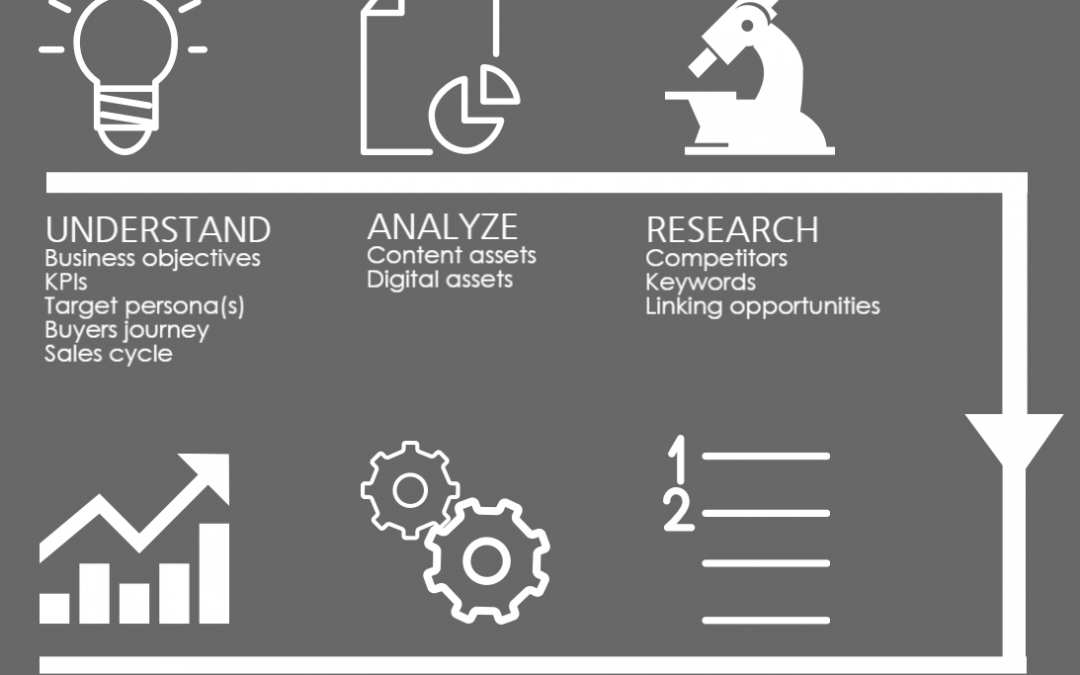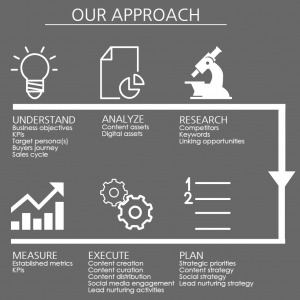
by Fronetics | May 18, 2016 | Blog, Content Marketing, Marketing, Strategy, Supply Chain
Fronetics’ six-step approach to content delivery helps elevate our clients’ brand position within the industry and drives growth.
The B2B buying process has evolved, and content is now an essential tool for generating and nurturing leads. Many businesses understand this: Reportedly, 88% of B2B marketers use content marketing as part of their programs, with lead generation (85%) and sales (84%) being the most important goals.
Many companies, however, find producing consistent, quality content — essential to a successful content marketing program — very challenging. Most don’t have the resources to make content a first priority, and many are unclear on what kinds of content will work for their business.
Fronetics Strategic Advisors partners with clients to create a content marketing program that drives growth. Handling all aspects from strategy to execution, our team leverages our vast and varied experience to deliver content that will elevate our clients’ brand position within their industry.
Our six-step approach to deliver content for our clients in the supply chain and logistics industries:
 Understand
Understand
Our first priority is to work with you to create the most effective content marketing strategy for your company. That means fully understanding the specifics of your business — your target customers, your sales cycle, your KPIs, and your competition — in order to create a content strategy individualized for your specific situation and needs.
Analyze
Next, we audit your digital assets: what is in place and how well it is working to produce your desired results. What kinds of content are you producing, how often are you producing it, and what is resonating with your target audience?
Research
We examine who your competitors are and what they are doing well (and not so well), identifying any gaps in the marketplace. We also research keywords that will resonate with your target audience and identify linking opportunities that will direct potential customers to your website.
Plan
We work closely with you to establish strategic priorities. We develop content, social media, and lead-nurturing strategies built on our careful research, understanding of your business goals, and analysis of the marketplace.
Execute
We begin creating, curating, and distributing content for your business. Unlike other firms, we don’t outsource content creation. By keeping it all in-house, we are able to ensure a quality product. Our team can create:
- Blog posts
- Articles
- eBooks
- Case studies
- White papers
- Newsletters
- Press releases
- Infographics
- Social media
- Custom content
Measure
Finally, we put metrics on all of these activities, monitor them regularly, and provide you with a monthly marketing report. We identify challenges, trends, and opportunities and take action so that your content marketing program constantly evolves and delivers results.
If you are looking to improve your content marketing to drive meaningful engagement with prospects and customers, speak with us today.
Related posts:

by Fronetics | May 16, 2016 | Blog, Content Marketing, Logistics, Marketing, Supply Chain

Dear companies in the logistics and supply chain industries,
You have leveraged technology and innovation so that two-day shipping is becoming more of the norm rather than the exception. You have developed processes and standards for IT Asset Disposal (ITAD), which mitigate asset recovery management and increase data security. You have leveraged 3-D printing — disrupting the status quo.
Cathy Morris, senior vice president and chief strategy officer for Arrow Electronics, Inc., puts it well: “Products can be made, money can be invested, ideas can be brought to fruition, but without the supply chain everything stops. The supply chain provides routes to market; everything hinges on an effective supply chain.”
In short, logistics and supply chain — you are pretty damn awesome.
Given your awesomeness, I wonder why marketing firms have taken to courting your business by promoting that they do “content marketing for boring industries.” You are not boring (in the least). Why would you choose to partner with someone that finds you boring?
Content marketing can be an effective tool for your business. When aligned with your business objectives, content marketing can:
- Build brand awareness
- Position your company as a thought leader within the industry
- Increase engagement with customers, partners, and stakeholders
- Educate and inform customers, partners, and stakeholders
- Build trust
- Allow you to manage your reputation
- Generate leads
Given the impact a successful content marketing strategy can have on your business, doesn’t it just make sense to find a marketing firm that recognizes the value of your industry and of your company; a firm that recognizes your awesomeness?
I lead the digital and content marketing arm of Fronetics Strategic Advisors. Our firm focuses on companies within the logistics and supply chain industries. Why do we do this? We do this because we have deep expertise in these industries, and because we believe in these industries. We stay up to date on industry trends. Phrases like: “Can you believe the capabilities of company x’s new forklifts?” and “Wow, the reverse logistics implications of that are going to be significant,” are daily conversations for us.
I am not saying that you need to choose our firm as your marketing firm, but, please, choose a firm that believes in you. When choosing an outsource partner, evaluate not just the firm’s marketing capabilities, but also their knowledge of your industry.
You do incredible work. Find a partner who recognizes this, not one who finds you boring.

by Elizabeth Hines | May 11, 2016 | Blog, Strategy, Supply Chain

If Seneca the Elder could have peered into the future, shock is likely too weak of a word to describe his reaction. The Roman rhetorician is credited for being among the first to complain about the overload of information when he, in the 1st century AD, lamented that the abundance of books had become a “distraction.”
Around 1440 AD, another round of complaints erupted with the invention of the printing press. Overwhelmed by the sheer amount of new information, scholars of the Gutenberg era found the proliferation of printed materials too difficult to manage.
Fast-forward a few centuries and you find articles titled “Death by Information Overload.” Published in 2009 by Harvard Business Review, the article makes a case that we’ve heard countless times over the past few years: We are drowning in a flood of data.
However, the writer, Paul Hemp, also makes a point that I want to focus on:
There’s hope, though. Innovative tools and techniques promise relief for those of us struggling with information inundation. Some are technological solutions—software that automatically sorts and prioritizes incoming e-mail, for instance—designed to regulate or divert the deluge. Others prevent people from drowning by getting them to change the way they behave and think. Who knows: Maybe someday even I will enjoy swimming in the powerful currents of information that now threaten to pull me under.
Nearly two years ago, I argued in this space that vendors would be wise to spend less time on their sales pitch and more time presenting data in a digestible format, ensuring compatibility with the end-user’s legacy systems, and aligning the solution with the end-user’s key performance indicators (KPIs).
Few people actually object to the value of data, and most are well informed of its potential impact, according to several surveys. Collected in a warehouse environment, data can profoundly boost productivity, safety, and inventory accuracy.
The issue that many still need to address is that all too often the step from collecting data to letting it drive decisions is more than the average organization can handle. Surveys show a surprising number of companies report they are either wary of advanced analytics tools or have failed to leverage the technology. Data generated by sensor-enabled technology, for example, does little good unless the end-user knows how to interpret and act on it.
But there are signs vendors are responding to the demand for user-friendly data. Just as you do not expect to sort through masses of data to find out how fast you are driving, leading vendors are eliminating and simplifying steps to help end users get the information that they are looking for without time-consuming analysis. New widgets or apps designed to consolidate data coming off multiple sensors will make data collection in the warehouse more accessible, and, as a result, more likely to lead to operational improvements.
Then talk of data overload may quiet down — until the next wave of disruptive innovation hits, that is.
What signs, if any, have you seen of more user-friendly data?
This article originally appeared in EBN Online.

by Elizabeth Hines | May 10, 2016 | Blog, Strategy, Supply Chain

Increasing operational expenses to avoid capital expenditures that would boost warehouse capacity and functionality might end up costing you more in the long run.
Consider this scenario: Demand is up and projected to grow for your products. But you are running out of space in your distribution center. Although you realize modernizing your distribution center to increase productivity would make sense, you resort to the seemingly more affordable solution — hiring more workers.
While many companies may balk at the upfront cost of investing in, for example, warehouse automation technology, holding off on upgrading in the name of saving money can become a costly long-term strategy.
Don’t get me wrong. Automation is not always the answer to tackling issues that stem from rapid growth, but companies need to be aware that doing nothing also comes at a cost. Increasing operational expenses to avoid capital expenditures that would boost warehouse capacity and functionality is generally not a good idea. More workers on the floor mean more congestion and delays, in addition to increasing the risk of higher turnover rates, as new employees are more likely to move on than longer-term associates.
In the end, if your productivity and order fulfillment suffer as a result of your inaction, so will your customer relationships.
FORTE, a Swisslog Company, made the following observation in SupplyChain 24/7:
Businesses routinely choose to not invest in distribution without giving careful consideration to the impact on operational costs and missed business opportunities. They thoroughly evaluate whether to purchase material handling equipment, warehouse software and distribution buildings. The same scrutiny should be applied to real and often hidden expenses and the opportunity costs of the option to do nothing.
In FORTE’s case, the company came to the “rescue” of a retailer who had planned to respond to a significant increase in demand and SKUs by hiring more workers to the tune of $900,000 to $3 million per year. Although labor costs would more than double, the retailer would still struggle to fulfill and deliver new orders on time. After much debate, senior management decided to spend $5 million on new material handling equipment and software to meet current and future demand.
So what issues can arise from the do-nothing strategy?
Well, take your pick among unwanted scenarios: Bottlenecks in pick zones; safety concerns as a result of increased congestion; double-handling due to an inability to confirm picks; discrepancies in putaway, replenishment, and picking stemming from the lack of automatic data capture and real-time tracking; and dropping productivity as employees, among other things, have to travel further to retrieve items.
If you have reached a point where you miss or ship incorrect orders, and adding labor seems to only compound the challenges, it is time to take a serious look at your priorities. Perhaps, investing in automation is finally justified?
This post originally appeared in EBN Online.
Related posts:

by Fronetics | May 2, 2016 | Blog, Content Marketing, Marketing, Social Media, Strategy, Supply Chain

Image credit: startbloggingonline.com
Here are three of the top benefits of social media for businesses in the supply chain and logistics industries.
We know that the majority of businesses participate in social media — in fact, a dominant 88% of B2B marketers report using these platforms as part of their marketing programs. Large corporations, small businesses, and those in between are promoting their brand and engaging with customers online. Even companies within the logistics and supply chain industries are joining the bandwagon and reaping the benefits of social media marketing.
The truth is, if your company is not participating in social media, you are at a disadvantage. Your customers, your employees, and your competitors are taking advantage of these technologies to conduct business in new, more efficient ways.
Why are so many companies using these tools?
Here are just three of the top benefits of social media for business:
1) Communicate and engage
By participating in social media, your business has at its fingertips a highly efficient, sophisticated platform for engaging customers, employees, potential hires, industry peers, and the general public. You can announce a new product launch; share small or sweeping changes in service, supplies, practices, locations, etc.; respond to questions or complaints; weigh in on industry discussions happening on online forums; and celebrate employee milestones and accomplishments.
2) Generate and nurture leads
Social prospecting is the process of using social technologies to identify and pursue potential customers that may be interested in your company but that don’t yet know about it. Your business can prospect from the 2.3 billion worldwide social media users, engage them with relevant content, and form and build relationships that you otherwise would have never encountered were it not for the World Wide Web.
3) Reduce marketing expenses
It’s free to set up social media accounts for your business. The real cost comes with dedicating resources to maintain and monitor the content on each channel, and those needs will vary from business to business. Even if you do chose to upgrade and pay for premium benefits and services, like ads, the cost is significantly lower than using many traditional mediums. One recent study suggests that the cost per thousand impressions (CPM) could be as low as $2.50, while traditional tactics, like direct mail ($57 CPM) and TV ads ($28 CPM), remain significantly higher.
Learn more about social media for business in Fronetics’ new white paper, Social Media and the Logistics and Supply Chain Industries. The paper defines social media and social technologies, identifies users and usage patterns, and describes more benefits companies within the logistics and supply chain industries can realize through participation.

Related posts:

by Fronetics | Apr 25, 2016 | Blog, Strategy, Supply Chain

Image source: tomicpasko | Flickr
They are your employees. They are your customers. Pretty soon, Millennials will be the supply chain.
As Millennials now outnumber Generation X and Baby Boomers in the workforce, shifts in ideas and processes were inevitable. But this generation is having an even more palpable impact: They are reshaping the economy as we know it, forcing businesses to reexamine traditional methods of buying and selling to accommodate their unique preferences and experiences.
A 2014 survey found that 46% of B2B buyers were Millennials, and that number is on the rise. Their preferences and behaviors are having a noticeable impact on B2B buyer behavior as a whole. In short, the supply chain should be prepared to change the way business is conducted to account for this generation’s impact.
Who are Millennials?
The term “Millennials” describes the generation of Americans born between 1982 and 2000. The more than 83 million Millennials represent a quarter of the US population, and are more diverse than any previous generation, with 44.2% being a part of a minority race or ethnic group.
Millennials are generally highly educated, though often underemployed and saddled with debt. They are digital natives who are decidedly collaborative by nature. Having grown up in a time of rapid technological advancement, their expectations and priorities are much different than previous generations. They’re delaying marriage and parenthood in favor of higher education and travel, fueling their strong sense of optimism. And they generally are reluctant to make major purchases — like homes, cars, and even music — instead favoring services that provide access to products without ownership, fueling the growth of the collaborative economy.
Ads be gone
Bombarded with over 5,000 marketing messages a day, every day for their entire lives, Millennials are able tune out traditional advertisements. They are turned off by direct sales pitches and much prefer word-of-mouth recommendations or joining communities around brands they like to learn about products and services. They are easily incentivized and want to be rewarded for their brand loyalty with things like discounts, access to information, and personalized communications.
Reshaping retail
Millennials are highly attached to technology. More than half go online multiple times per day, while more than a third (36%) report going online “almost constantly.” Approximately 90% are active on at least one social media network. They expect brands and businesses to have a digital presence and engage with them online — especially if they have a complaint or problem.
Having the internet at their fingertips shapes how Millennials shop. Their constant access to product information, user reviews, and price comparisons allows them to favor brands and products that offer maximum convenience at the lowest cost. Catering to their proclivity for the best for the least, giant retailers like Amazon have reset expectations for shipping times, availability, and price.
Millennials have taken shopping mobile. Around 92% will use a mobile device while they shop, and 78% will use an app to shop. And the revolution is far from over : Artificial intelligence, robots, and drones represent a new wave of technology that many tech companies, driven by Millennial innovators, are just a short step from achieving.
Related posts:

 Understand
Understand






